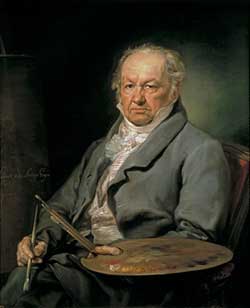
In a two story house just outside of Madrid, called “Quinta del Sordo” (Deaf Man’s Villa), a collection of 14 paintings literally covered the walls. Unlike most murals, these paintings weren’t meant for decorative purposes. Instead, they depicted feelings of anxiety, fear, depression, violence and a path leading into deep, dark madness. At the age of 72 the great artist, Francisco Goya, embarked on a disturbing journey within the walls of that two story house and from 1819 until 1823 he lived and breathed what is now known as the “Pinturas Negras” (Black Paintings).
Goya’s Motivation for The Black Paintings
By the time Goya bought the house from the deaf owner, he was suffering from various torments. Ironically, he was almost deaf himself and his health always bordered on a very dangerous cliff since he reached his mid-forties. Up until that point he had managed to survive two fatal illnesses, but the price he paid for surviving came with the haunting ideas that relapses may occur at any time. Even though he never returned to a completely healthy life, he desperately wanted to hang on to what he had left. The fear of falling back into scenarios where death had a better chance of winning never left his consciousness.
Apart from his medical condition, the turmoil in the Spanish government along with the effects of the Napoleonic war only elevated his depression. He had personal experience with the fear and hysteria that surrounded the people at that time. His artistic nature placed him in a difficult position, because this forced him to observe and absorb not just the pain he was feeling, but the pain of those around him as well. When he moved into that house he decided to make a personal gallery; a gallery that wasn’t meant to be seen by the public, a gallery to help him make peace with his personal hell. Nobody can say for sure when he started painting or if he gave the paintings titles. Their current titles as we know them were given by art historians and in 1828 a friend of Goya, Antonio Brugada, catalogued them for the first time.
The Paintings:
Saturn Devouring his Son
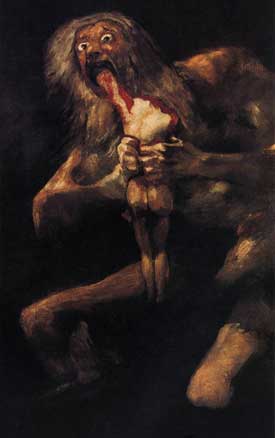
Probably the most famous painting of the Black Collection, it shows Saturn eating his son piece by piece. The god of gods is shown as a grotesque monster with great madness in his eyes. With no room left for remorse, his hands tightly grip the body of his son while his mouth rips off another limb. It almost looks like the tip of Saturn’s fingers have sunk into the body, making sure his son can’t get away. The blood flows freely as the body now hangs lifeless and cold.
The Dog
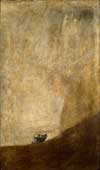
basically drowns out the dog and the slope. The true meaning of the painting is still disputed, but many believe the dog is a symbol of humanity, helplessly looking up at the sky in hopes of some miracle.
Two Old Men
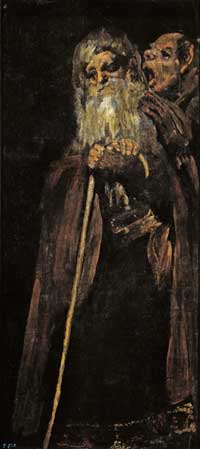
In front of a completely black background there are two, very different, old men. The one with the long beard seems at peace, while the other one who looks more demonic yells into the ear of the first old man. Like most paintings from this collection, the meaning can only speculated, but the second old man does seem to haunt the first.
Men Reading
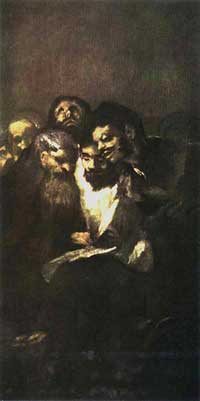
Along with “Women Laughing”, this painting is vertical and smaller than the rest of the pieces. In comparison to the rest the subject matter isn’t as dark, but the colors are. One central figure holds a piece of printed paper while 5 other men hover around him in discussion over what is read. It is believed they represent politicians.
Judith and Holofernes
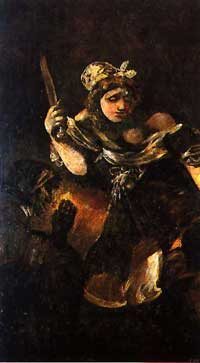
The scene where Judith slashes the throat of Holofernes has been painted several times by different painters and it typically represents the defeat of tyranny. Even though Goya secretly hated the Spanish King, he never publicized this emotion. However, in the privacy of his home there weren’t any restrictions.
Man Mocked by Two Women
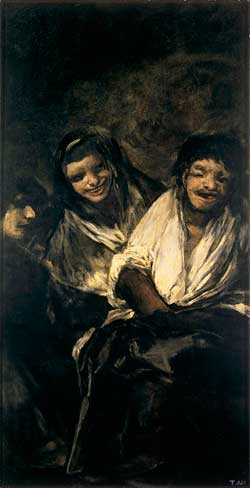
Critics believe that the two women are laughing at the male figure either because he is masturbating, exposing himself, or he is simply retarded. Some even suggest that they are smiling because they are also masturbating. The meaning behind the scenario according to critics is most likely the shamelessness of an exhibitionist, along with self-mockery and loneliness.
The Seductress
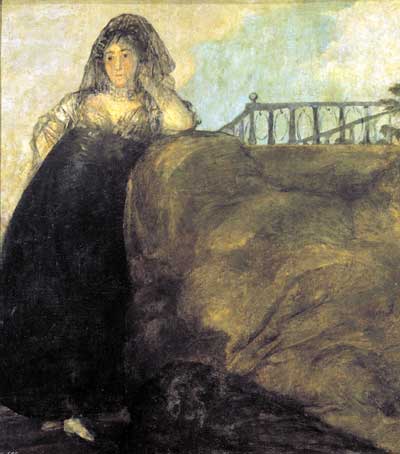
It is believed that the model in this painting was Goya’s maid and this conclusion comes from earlier paintings. With a funeral atmosphere, the model has a nostalgic expression on her face along with a sense of mourning.
The Fates
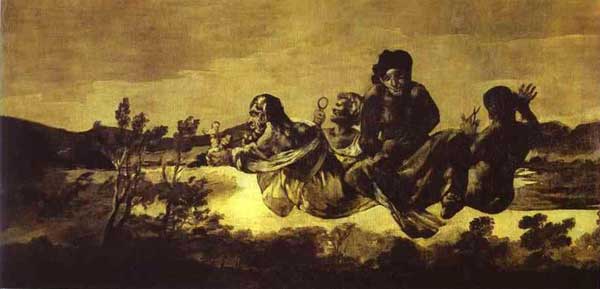
This is most likely Goya’s interpretation of the goddess of destiny, escorted by the ladies of the night. The limited use of colors represents a night setting and the scissors in the hand of the goddess is used to cut the cord of life. A figure at the back, presumably male, is bound in order to keep him from interfering with his fate.
Fight with Cudgels
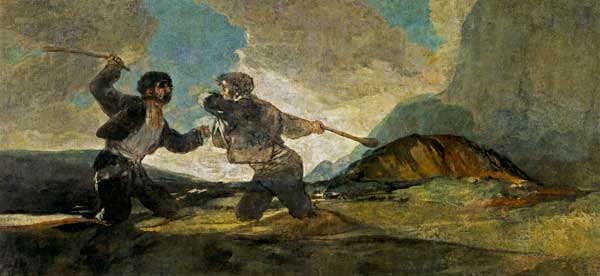
Using another mythical approach based on Cadmus and the dragon’s teeth, Goya points to the policies of Ferdinand VII; creating chaos in order to find a measure of peace.
Two Old Men Eating Soup
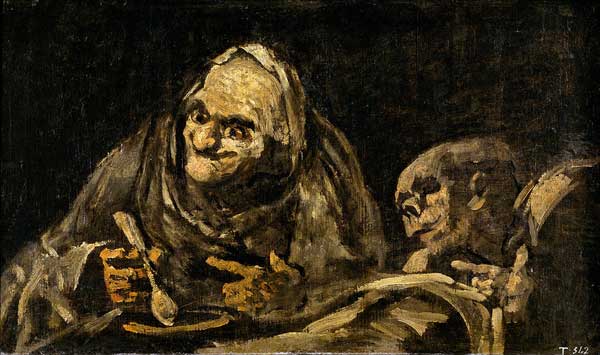
Despite the given title, it seems that only one of the old man is actually alive. The latter carries on eating while the other looks more like a skeleton. With rapid brush strokes and great decisiveness it looks as if Goya tried to find some comfort in the company of death.
Fantastic Vision
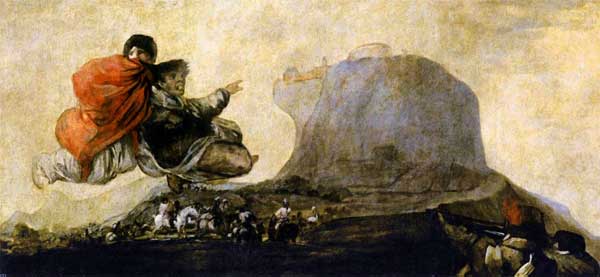
A male and a female figure are flying above a group of people who are moving towards a mountain. On top of the mountain is a town and critics believe it’s a well-known place where Spanish liberals fled to during the war. At the forefront French soldiers get ready to fire upon the group.
Procession of the Holy Office
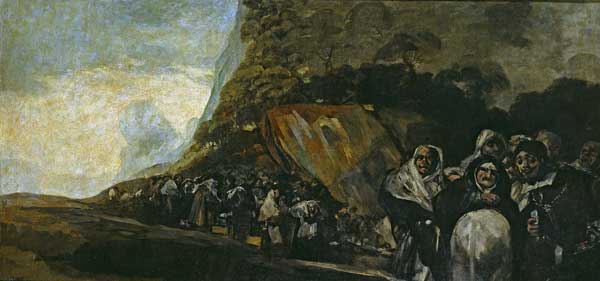
This piece shows a pilgrimage by crippled and sick people, led by holy figures. They are on their way to St. Isidore in hope of finding a cure for their illness, but as can be seen in the expression of the figures at the forefront, many are skeptical that the pilgrimage will be successful.
The Witches’ Sabbath

The devil stands before a group of fearful witches and he takes the form of a goat dressed in typical clerical clothing. His mouth is wide opening, screaming at the covenant before him. Critics believe Goya symbolizes the king in his “The Junta of the Philippines” where respect was forced and not earned.
The Pilgrimage to San Isidro

Thirty years before he painted the black collection Goya painted “The Meadow of San Isidro”, and this is considered the exact opposite. Where once the image was colorful and joyful, it’s now filled with characters that seem drunk and disfigured. As the groups disappear in the background they become more dehumanized.
For about 70 years these paintings stayed within the walls of that house until they were finally placed on canvas by a curator called Salvador Martinez Cubells from the Museo del Prado, where they are now exhibited. When Goya moved out of the house and exiled himself, he never looked back on the work he left there.
You must be logged in to post a comment.